
Hey there, we’re back again this week with another look at Tuning NO RUG! In last week’s article I elaborated on the thought process that went into my recent version of NO RUG. This time we’re going to look at mulligan decisions and sideboarding plans with the deck.
I originally planned to include an in-depth analysis of an entire match against Bant Aggro, but it would be better to devote a separate article to that so we can look at some of the more complex decisions that go into match play with the deck, so be on the lookout for that next week! For this week join us as we jump into mulliganing and sideboarding with NO RUG!
To begin, let me share with you a hand I opened in testing that led to a very interesting game (sadly I didn’t record that one). Then I’m going to explain what kind of hands you should keep or mulligan, and what you’re generally looking for in a game one scenario when you don’t know what you’re facing. After that I will give you some more hands before moving to the sideboarding plans.
The list I’m using for the sample hands and boarding plans is almost my exact 75 from last week:
NO
| [Business] (41) 4 Force Of Will 3 Mental Misstep 2 Spell Pierce 4 Lightning Bolt 3 Fire Ice 4 Brainstorm 1 Ponder 1 Sylvan Library 3 Green Sun’s Zenith 4 Natural Order 4 Noble Hierarch 2 Tarmogoyf 2 Terravore 3 Vendilion Clique 1 Progenitus[/Business] [Mana Sources] (19) 2 Dryad Arbor 4 Misty Rainforest 1 Scalding Tarn 4 Wooded Foothills 2 Taiga 3 Tropical Island 3 Volcanic Island[/Mana Sources] | [Sideboard] (15) 2 Grim Lavamancer 1 Scavenging Ooze 2 Ancient Grudge 3 Red Elemental Blast 3 Submerge 2 Surgical Extraction 2 Jace, the Mind Sculptor[/Sideboard] |
The only change is moving the Sylvan Library to the main deck over the second Ponder, and adding the third Red Elemental Blast to the sideboard. I tried this out before, but never seemed to draw the Library with enough frequency to come to a solid conclusion either way. It hasn’t been showing up with any more frequency the past thirty or so testing games either, so I’m still deliberating on this. A lot of players keep on saying how strong it is though, so let’s see if it shows up sooner rather than later.
Section One: Mulligans
Sample Hand #1
With the above list, I drew these seven in a testing game on the draw:
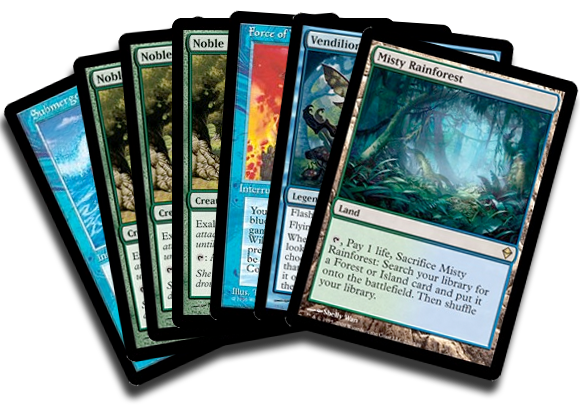
This was game three against Bant Aggro, so I knew I had to expect Wasteland. I had also seen Stoneforge Mystic, so Umezawa’s Jitte was a strong possibility. With this hand you pretty much just lose to a Wasteland and a removal spell (or Mental Misstep on your first Noble Hierarch). You also don’t have access to Red mana with this hand (unless you fetch Taiga), which might be an issue later in the game. On top of that the hand is light on business and if you use Force Of Will to protect Vendilion Clique you have nothing else left (that Clique will most likely be a three turn clock though). It could still be legend-ruled away, so I shipped this hand and opened these six amazing cards (sample hand #2):
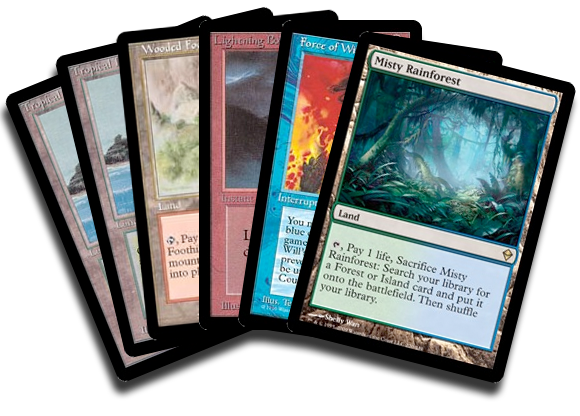
You have no business and only one removal spell. Force Of Will is also not online, so regardless of whether you draw a Blue card or not, this hand is an essential mulligan to five. You might not get blown out by Wasteland but you lose to pretty much everything else your opponent will do. I have seen much better five card hands, so this is a clear mulligan.
Then, when I drew my five card hand after the second mulligan, I had to laugh (sample hand #3):

I kept that hand and my opponent led with Tropical Island into Noble Hierarch. I drew my third Hierarch, dropped my land, Submerged my opponent’s Hierarch (not facing a turn two Knight Of The Reliquary was crucial at this point and I didn’t want to use the Force Of Will already and lose to a Daze) and cast my first Noble Hierarch. I went on to win that match by the way. I think this really is an interesting example. There’s some sick variance, there’s a borderline okay hand and I managed to win the game on a mull to five with a mediocre hand.
General Mulligan Guidelines For NO RUG
So what is it that makes hands goods in this deck? It’s very important to ship hands without serious business, as I mentioned previously that you will generally be the aggressor in most matches. In most matchups this means you want at least one of your threats in your hand. Against combo decks you can keep hands that aren’t very aggressive, but only if there’s enough disruption in your hand. Against everything else I usually ship every hand that doesn’t have at least a Green Sun’s Zenith I can search Tarmogoyf with at the bare minimum, but you much rather want the turn three Natural Order or turn two Vendilion Clique.
For most of your hands, you want to have at least two lands and either a Green Sun’s Zenith or a Noble Hierarch. The latter is obviously stronger and makes for a more stable and versatile manabase, and while you actually can cast all of your spells off of two lands and a Dryad Arbor as well, it’s more susceptible to Wasteland. You also don’t want to keep hands that only have one type of lands (all Tropical Islands for example). This should be obvious but I thought I’d mention it.
Disruption is actually the least important thing you need, as your gameplan is so strong that most opponents will be forced to be the control deck and have to react to what you’re doing. When you can jam threat after threat, there’s not much need for disruption – most of the time you will naturally draw some form of disruption anyway. Having a Mental Misstep for a key Brainstorm or removal spell is always nice. Keep in mind what you’re playing against though, if there are any plays you would outright lose to, it’s most often better to mull a hand without countermagic or removal. Also note that against some decks, dropping a Tarmogoyf or a Terravore can heavily disrupt their gameplan (Zoo, Goblins, and sometimes Merfolk for example).
In the few matchups where you’re the control deck, the importance of threats and disruption changes. You want disruption instead of threats here, but having strong mana is important nonetheless – you just don’t have to factor in being hit by Wasteland. Good thing Vendilion Clique does both, beating down and disrupting your opponent, while Green Sun’s Zenith serves as both mana and a threat.
With the deck broken down to mana, threats, and disruption, there are seven cards left. Progenitus is something you never want to have in your opener and is usually a mulligan (unless you have something like double Clique that can be used once on yourself to bottom the Progenitus). If the hand around it is very strong, you should probably keep it, otherwise, go ahead and ship it. There’s also no way you can keep a hand without either Brainstorm or Vendilion Clique and at least one additional piece of countermagic when your plan is to resolve Natural Order early. Given that this is the strongest plan for most matchups you should most certainly shuffle hands with Progenitus away.
Then we have cantrips and Sylvan Library. Sylvan Library can sometimes be considered a threat, depending on what you’re playing against. It does actually give you a lot of late game power. One thing about this deck (and most others) is don’t ever rely on cantrips to improve your hand. You should almost always mull a seven card hand with only one land. Even if it has a cantrip and a Zenith or Hierarch. This is very important and NO RUG mulligans nicely so you often get profit out of your mulligans. You can definitely keep a hand with mana, cantrips, and either disruption or creatures, though this is greatly matchup dependent.
Sample Hand #4
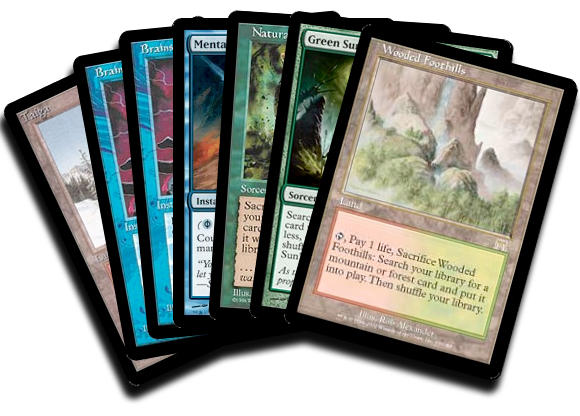
This hand isn’t perfect, but I think it’s a clear keep. You have serious business in Natural Order (plus an outlet to sacrifice), some light protection, good mana, and two Brainstorms. If your opponent is not prepared for the Natural Order or you draw a counterspell or Vendilion Clique before you cast Natural Order (highly likely) you’re most definitely going to win.
You could go for the turn one Zenith, but I prefer getting more value out of my Brainstorms. I would just lead with Wooded Foothills and then crack it for Tropical Island in my next turn, casting Brainstorm and shuffling with Green Sun’s Zenith. This play is especially strong on the draw against a deck with Wastelands since it nicely plays around it. Note that I usually don’t tend to cast my Brainstorms early on, but in this case it’s definitely worth it. Turn three Natural Order is so strong that you want to have it pretty much whenever you can. Also, in case of Wasteland you can draw another Blue source before you expose yourself to get hit.
If you’re facing combo, I wouldn’t cast the Brainstorm. I would keep mana open for it (leading with Foothills) and only cast Green Sun’s Zenith on turn two, then shipping the turn. You’re still likely to set up the turn three Natural Order this way (you have up to three draw steps until you see a third land) but are more flexible. There’s really not much that can go wrong with this hand.
Sample Hand #5
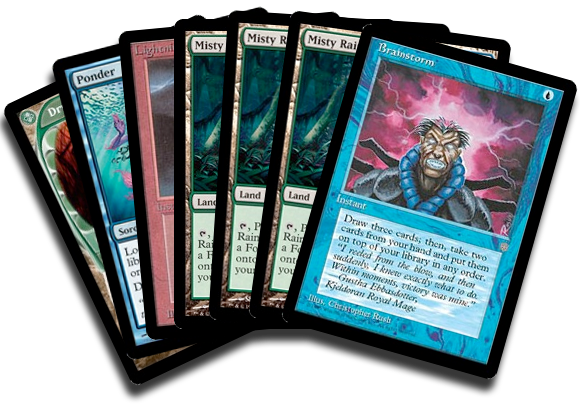
This is one of the weird opening hands I tend to get. I wouldn’t keep it. This is pretty much a mulligan to six already with Dryad Arbor in hand anyway – at least you have Brainstorm to shuffle it away though. This hand has strong mana, but no threats and not much else. You could just Ponder into the nuts but you could also totally whiff on your cantrips and not get there with this hand. It’s borderline keepable, but I think this deck produces strong enough six- and five-card hands to justify a mulligan. Here’s what I opened on my mulligan to 6 (sample hand #6):
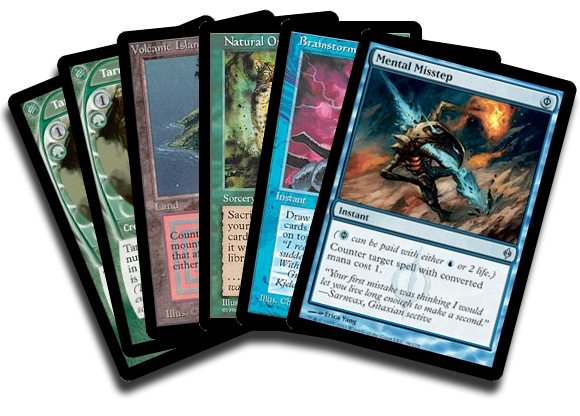
This is clearly a mulligan. The mana is obviously bad with Green being your main color and Tarmogoyf is unimpressive in a lot of matchups as well. There’s not much to talk about here as you can’t even hold on to your Brainstorm without exposing yourself to Wasteland. On I mull to 5 here’s what I fanned open (sample hand #7):
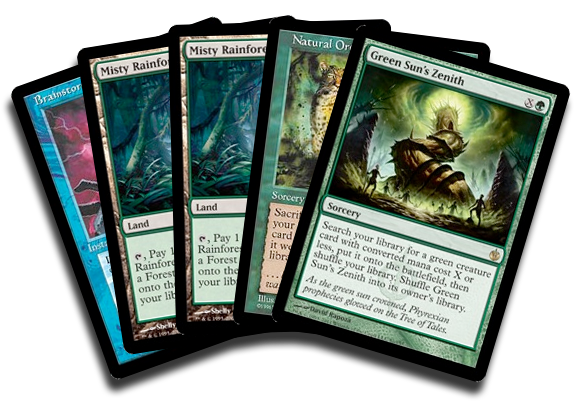
This hand is actually quite strong and has all the ingredients for a successful game with NO RUG. It’s kind of like Sample Hand #4 with slightly better mana and without protection. With this hand I would actually go ahead and cast the first turn Zenith (off a Tropical Island) since you have a blue source for Brainstorm and the shuffle effect turn two without having to hold back your Green Sun’s Zenith. You could also draw into Vendilion Clique and that’s totally worth it. This hand can lose to a disruption heavy draw from your opponent but is actually likely to just get there since you only need a land and some form of protection. Quite manageable with five to six extra draws, depending on whether you’re on the draw or on the play.
Section Two: Boarding Plans
I usually dislike giving out these, as my boarding plans can vary a lot, and I understand that everyone’s metagame can be very different. Often it depends on what you expect your opponent to bring in, and what you find them most likely to focus on in the game. This is especially important when your opponent is gunning to beat Natural Order. You might trick them into boarding a lot of hate while you board out the package. This also works vice versa; your opponent boards an abundance of spot removal and you board out the beatdown plan, leaving only Cliques, Hierarchs, Natural Orders and protection. This is the move I usually pull against control decks, since Vendilion Clique and Natural Order are the threats you have that are the hardest to interact with and Vendilion Clique, even if removed, often pulls its weight.
Here are some samples of my recent sideboard plans.
Stoneblade:
-2 Tarmogoyf
-2 Terravore
-3 Green Sun’s Zenith
+2 Grim Lavamancer
+2 Ancient Grudge
+3 Red Elemental Blast
As I said before, something like this is what I do against most control decks. This plan is tailored for the German metagame, where most Stoneblade decks are splashing Red for stuff like Red Elemental Blast and Grim Lavamancer. Recently, Punishing Fire + Grove Of The Burnwillows has seen some play as well, so in case you’re facing that, you might consider bringing in Surgical Extraction instead of Grim Lavamancer to remove their Punishing Fires. Also note that against these lists Jace is not too good as they have a lot of outs in Grim Lavamancer, Red Blasts, their own Jaces, Punishing Fire, Vendilion Clique, and who knows what else they might have. This plan has been treating me well.
NO RUG mirror:
…is a pain. You don’t really want to play the mirror and there’s a lot of different stuff you can do. You definitely want to bring in Submerge and sometimes you can actually board out Mental Misstep as long as there’s no Spell Pierce to worry about. Grim Lavamancer nicely supplements Fire/Ice, but I wouldn’t focus on using the graveyard too much considering most lists are packing a Scavenging Ooze somewhere in the 75. You can also board out Lightning Bolts, as these aren’t nearly as strong as Fire/Ice and can’t lock up a game as easily as Grim Lavamancer. Red Elemental Blast is also a possibility to fight your opponent’s Cliques or countermagic. Lists with Terravore really have a slight edge here if only for having more (real) beatsticks. This is only one of the many plans you could use:
-2 Tarmogoyf
-4 Lightning Bolt
+2 Grim Lavamancer
+1 Scavenging Ooze
+3 Submerge
With both players being likely to exile stuff from graveyards, boarding out Terravore over Tarmogoyf is okay as well, you just have less bombs then. Everything’s possible, and Umezawa’s Jitte is very powerful if either player is bringing it in.
Merfolk:
-1 Progenitus
-4 Natural Order
+2 Grim Lavamancer
+3 Red Elemental Blast
Relying on Natural Order is a bad idea in this matchup. You’re hardly ever going to resolve it and Merfolk is a deck that can reasonably race Progenitus, especially when you’re playing around Daze effects. Vendilion Clique can steal a crucial AEther Vial activation from time to time (in response to Vial tap trigger flash in your Clique to nab their creature), and can also serve as a three mana Lightning Bolt if played before declare blockers phase (to ambush an attacker), with built-in hand disruption as the bonus. I have also found Terravore to be valuable here (even more so than Tarmogoyf). If you’re concerned about running Terravore alongside Grim Lavamancer, I haven’t found this to be an issue yet. You can board them out for Ancient Grudges (if you expect Jitte) or Jaces though.
Bant Aggro:
-2 Tarmogoyf
-3 Vendilion Clique
+2 Ancient Grudge
+3 Submerge
Again, this is only a suggestion, but I’m serious about boarding out Clique in this matchup. Most lists are running only Daze and Mental Misstep in terms of countermagic right now and these are hardly going to stop you. Apart from Clique not being much needed as disruption, it’s also generally weak against their deck as a body. Umezawa’s Jitte is very strong against you already and some lists even started running pesky creatures like Scryb Ranger. Not where you want to be with spending three mana for Vendilion Clique. Tarmogoyf is also very weak here as it’s rarely better than a 3/4. As for their threats, you mostly need to watch out for Knight of the Reliquary (apart from Stoneforge Mystic). The inclusion of Terravore improved this matchup by a wide margin. I don’t bring in Grim Lavamancer here because we are definitely the beatdown deck in this matchup and Grim Lavamancer doesn’t add much to that aggressive gameplan.
By the way, this is pretty much my boarding plan against Maverick as well. A lot of Maverick lists are running Mental Misstep anyway, so the matchups really aren’t that different – Maverick lists only have a few more utility creatures instead of Brainstorm, more countermagic and possible Vendilion Cliques or Jaces.
Zoo:
-3 Vendilion Clique
+3 Submerge
There’s not much to worry about against Zoo. Deal with their early assault and then drop big Green monsters. Both Terravore and Progenitus are pretty hard to deal with for them outside of racing so you should focus on doing exactly this: Racing. If it’s a fast Zoo list without Knights and with lots of burnspells, you should often use Submerge early (within the first two turns), whereas against Big Zoo, you should wait for Knight of the Reliquary, or, if you expect them to have it, Aven Mindcensor. Against Big Zoo you can also board out your Tarmogoyfs for Grim Lavamancers or Ancient Grudges, depending on what you feel is most needed against the list you’re playing against. Boarding Scavenging Ooze is also a possibility, but I prefer to focus on beating.
Dredge:
-1 Vendilion Clique
-4 Lightning Bolt
-1 Sylvan Library
+1 Scavenging Ooze
+3 Red Elemental Blast
+2 Surgical Extraction
This is pretty simple. Clique isn’t great in this matchup, but it’s still a threat and can swipe one of their dredgers from their hand. Lightning Bolt is almost strictly worse than Red Elemental Blast since you can use both to blow up Narcomoeba in their drawstep to prevent them from casting Dread Return or Cabal Therapy, but Red Elemental Blast also counters their Breakthrough and Careful Study. It doesn’t kill your creatures to get rid of their Bridges if need be, but you still have Fire/Ice and Natural Order for that. Sylvan Library isn’t needed here as games are decided within the first two or three turns – either they go off or you should have control of the game. Most of the time you should use your Surgical Extractions for their Ichorids or Narcomoebas, but Bridges, Therapies, and sometimes Dread Return creatures can also be legitimate targets depending on the flow of the game. Scavenging Ooze is obviously your silver bullet that can be fetched with Zenith, and is pretty huge in this matchup.
Reanimator:
-1 Sylvan Library
-3 Fire/Ice
-4 Lightning Bolt
+1 Scavenging Ooze
+3 Red Elemental Blast
+2 Surgical Extraction
+2 Jace, the Mind Sculptor
Again, just a suggestion. Having Jace goes a huge distance in this matchup and kinda offsets the loss of Sylvan Library (you don’t want the game to last that long for it to become important anyway). You don’t necessarily need Surgical Extraction, but it can help a lot in exiling Reanimate or Animate Dead targets or sometimes even Entomb (not recommended, but this can do the trick). Scavenging Ooze is obviously huge but watch out for them to board in the Show and Tell plan to circumvent your graveyard hate. Good thing you have countermagic and bring in Red Elemental Blasts (these also help answer Jin-Gitaxias, Core Augur). If this becomes big again and Hive Mind continues to decrease in popularity, you could swap the Surgical Extractions for Faerie Macabres, which are way better for this matchup and also reasonable against Dredge.
Hive Mind:
-1 Progenitus
-4 Lightning Bolt
-4 Natural Order
+2 Grim Lavamancer
+3 Red Elemental Blast
+2 Surgical Extraction
+2 Jace, the Mind Sculptor
This is what I do against most combo decks, but against Storm you can keep in the Lightning Bolts and leave the Grims and Extractions in the board. Against Intuition-fueled decks Surgical Extraction is pretty strong though, especially against Hive Mind since they can’t use Pact of Negation for protection after an endstep Intuition. Grim Lavamancer is better than Lightning Bolt here because it will most likely deal more damage over the course of a game and Natural Order is just way too slow. Fire/Ice stays in because it can work as a pseudo-Daze, pitch to Force of Will, or just cantrip.
Team America:
-4 Lightning Bolt
+1 Scavenging Ooze
+3 Submerge or +3 Red Elemental Blast
There are lots of different routes you can take for this matchup, depending on what kind of list they’re playing and what you have seen game one. I generally prefer the plan above, with Submerge for lists with more Tombstalkers and Red Elemental Blast for lists with more Vendilion Cliques and Mind Sculptors. Of course you don’t always know what they’re running, but you should be able to at least make an educated guess after game one. Alternatively, you could go this route:
-1 Progenitus
-4 Lightning Bolt
-4 Natural Order
+2 Grim Lavamancer
+3 Red Elemental Blast
+2 Jace, the Mind Sculptor
This is my plan if I expect them to have a myriad of removal, especially sweepers like Pernicious Deed and most importantly Perish. This plan is also stronger against lists packing more Confidants and Jaces. You should consider boarding in the Scavenging Ooze to handle Darkblast; since you’re not trying to resolve Natural Order anymore, you can cut the second Dryad Arbor for it.
Conclusion
Overall, I like the philosophy of sticking to the hardest-to-deal-with threats for my postboard games. I tend to board out the worst (least needed) disruption or the worst threats, depending on what I’m playing against. The only thing to keep in mind here is to not play a one-dimensional deck postboard, but that’s hardly possible anyway. Even if you board out the Zenith or Natural Order plan, you’re left with your utility creatures and either regular creatures or Progenitus, and sometimes Jace.
NO RUG has some very strong boarding plans and even with a list that’s tuned to beat a specific set of decks (you beat ’em all anyway) you have lots of routes to explore. This makes for interesting games and versatile boarding plans. Boarding can be hard at first but will be easier once you figure out what you expect from the deck. You can pack a lot of tricky stuff in your 75, but I prefer keeping it simple, which is mirrored in my playstyle and thus my boarding. Don’t hesitate to try things out.
That’s it for today. Last week we went through the theory behind my list, this week we had theory about how to prepare for individual games, and next week we’ll get to in-game theory against a specific deck. I know this might be a tad too much about only a single deck, but NO RUG is becoming more and more popular so even if you’re not looking to play the deck you should still know how it works. This may contain no juicy tech, but I felt if I wasn’t going to share the boarding plans for my list I shouldn’t have posted it in the first place.
After I wrap up writing about NO RUG we may discuss some Stoneblade content (boring for some, I know, but it’s hard to justify not playing Stoneforge Mystic in Legacy control) or something completely different. What do you want to read about? Please let me know in the comments below or in the forums! But let me say this: Fire/Ice is absurdly strong right now and might actually be the best removal spell in Legacy at the moment. You should start testing them in whatever you’re playing; chances are they’re preeeeetty good.
See you next week!
